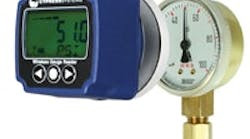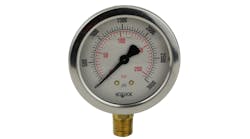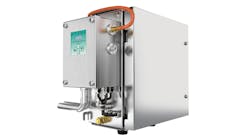“Thousands,” says Conoco-Phillips’ Alan Autenrieth, who has installed a large wireless system in his plant using Honeywell’s OneWireless technology. “I have no idea how many.”
There are places in the plant where we have not wanted to install transmitters for a number of reasons. So we install gauges, and send operators and maintenance personnel on gauge rounds.
For Ireland, “something else” is installing wireless gauge readers (WGR) from Cypress Systems. A combination of a solid-state CCD camera such as those in cell phones, a microprocessor/digital display and a message-based wireless radio node, the device fits over the existing gauge’s faceplate, captures the image of the gauge face, translates that image to a digital value, and displays and transmits the digital value and the gauge image to a server on a selectable interval from about 3 seconds to hours.
“With WGRs,” Ireland said, “I can have the data from gauge rounds, and I get it in much more usable fashion, through an OPC server, not as scribbles on a clipboard.”
Ron Farry, equipment engineering manager for Micrel, Inc., San Jose, Calif., agrees. “The payback from installing these devices was about four months,” Farry said.
ARC Advisory Group’s Wil Chin points out, “Workforce reductions are motivating organizations to increasingly adopt online plant asset management (PAM) solutions. Using the Cypress Wireless Gauge Reader allows real-time distribution of critical asset information to PAM systems enabling the workforce to take proactive action. With millions of installed gauges in manufacturing plants and the relative ease of installing the reader, the market for this device can be huge.”
The wireless gauge reader is only one of a new set of devices that Cypress Systems CEO Harry Sim calls, “…nontraditional sensors. These are sensors that we can now use because of lower cost, better reliability, ease of installation with wireless, or any number of other reasons, where it wasn’t practical to put in transmitters in the past.”
Honeywell’s David Kaufman calls this the real value of the plant-wide industrial wireless network. “We are going to see networks of ‘lick-n-stick’ sensors,” Kaufman says, “and we will be able to use that information to optimize operation, maintenance and reliability of our plants in ways we have not yet imagined.”
The power of wireless is only partly the existing sensor networks. Emerson Process Management’s chief strategic officer, Peter Zornio, concurs. “By far the larger opportunity for wireless is the ‘want-to-have measurements’ that could not be cost-justified previously. A good ‘want-to-have’ measurement example is the continuous monitoring for vibration or other operating parameters on rotating equipment, where earlier decisions were made to do only periodic manual checks. Heat exchangers, which are generally run until they clog, represent another excellent potential application for wireless. ”
Zornio continues, “The best examples of “want-to-have measurements” are the many manually operated (or even automatic) valves that today provide no position feedback. Yet the information is important, since incorrectly positioned valves represent a significant cause of safety-related incidents in the process industries. Reports often tell that operators thought a valve was closed, but it wasn’t, and an incident ensued. Since wireless monitoring of the infrequently used valves is only 10% or 20% of the cost of a wired solution, the applications become a lot more attractive. Position feedback monitoring is a very real safety factor, and it may well become the single largest application area for wireless devices in process industry plants—at least in the near future.”
For more information on “non-traditional” sensors go to www.controlglobal.com/wirelessguide.html




